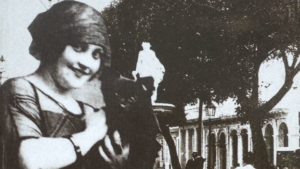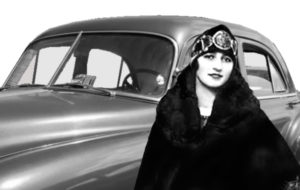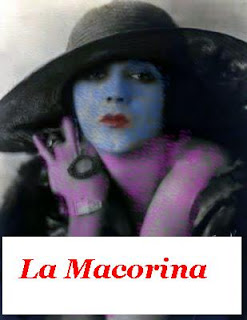María Calvo Nodarse or “La Macorina”, was a famous Cuban woman born in the town of Guanajay, Pinar del Río in December 1892, her real name being María Constancia Caraza Valdés. Since her childhood is not known much, only it is known with accuracy that at age 15 she fled her home and moved to Havana in the company of her boyfriend and only love, but the economic hardships made her abandon her romance and enter the world of prostitution.
The audacity and beauty that this woman possessed made her go into the most select circles of the Cuban society of the time, according to her attractive personality and her beautiful eyes already help to be one of the most elegant and famous prostitute of the time. She was not a prostitute in the indiscriminate sense that this profession entails, nor did she work in a brothel, but instead prostituted herself selectively. And she began her rapid career towards opulence, according to Guillermo Villarronda’s interview with Bohemia magazine on October 26, 1958: “more than a dozen men were surrendering at my feet, flooded with money, supplicants of love ‘ She was the friend of wealthy Havaneros dedicated to politics and business, among them José Miguel Gómez (popularly known as “Tiburón”), whom she helped with her loyalty during the events of ‘La Chambelona’.
Regarding the origin of her nickname “La Macorina”, it is said that on one occasion, while Maria was walking along the sidewalk of the Louvre, a young man who had drunk more than the bill said as the beautiful woman passed by: ¡La mara la Macorina! He really wanted to say La Fornarina (really called Consuelo Bello), a famous Spanish cupletist, contemporary of the Spanish Raquel Meller and the Cuban “La Chelito” (“La Coquito”). He wanted to compare her to Fornarina but his drunkenness made him say “Macorina”.
His decline and death
The Macorina was so popular that not only has in its honor two musical compositions and a painting by Cundo Bermúdez, but it was immortalized in the famous Bejucal charangas, which are celebrated in the month of December, where the parades of characters featured a doll with mask under which was its creator, a mason named Lorenzo Romero Miñoso. The Asturian Alfonso Camín wrote his famous poem “Macorina” that the Mexican singer Chavela Vargas transformed into one of the best-known songs of his career.
CHAVELA VARGAS CANTA ‘MACORINA’
After having accumulated wealth and being part of the most selective social circles of Havana, the national economic situation was no longer so prosperous, but perhaps the indisputable fact was that Macorina was then 42 years old. The friends of the past were sheltering in excuses every time she asked for help, and so she sold all her belongings, from the jewels to the houses and the cars: the Macorina ended in the most absolute poverty, living in a room rented in a habanera family house.
La Macorina began losing youth and popularity inexorably, she had to sell her nine cars, her four mansions, her clothes, jewelry, furs, everything and she died almost in misery. Qualified by some as the Cuban Hari Mata, it is known that Macorina, in addition to being the first woman who obtained a license and drove a car, had a dissipated life, from which in her old age she repented. She died in Havana.
 PERSONAJES CUBANOS: MARÍA CALVO “LA MACORINA”, FAMOSA ENTRE LAS MÁS BELLAS MUJERES DE LA ÉPOCA.”
PERSONAJES CUBANOS: MARÍA CALVO “LA MACORINA”, FAMOSA ENTRE LAS MÁS BELLAS MUJERES DE LA ÉPOCA.”
María Calvo Nodarse o “La Macorina”, fue una célebre mujer cubana nacida en el poblado de Guanajay, Pinar del Río en Diciembre de 1892 siendo su nombre verdadero María Constancia Caraza Valdés. De su infancia no se conoce muchos datos, solo se sabe con exactitud que a los 15 años huyó de su casa y se trasladó a La Habana en compañía de su novio y único amor, pero las penurias económicas la hicieron abandonar su romance y entrar al mundo de la prostitución.
La audacia y belleza que poseía esta mujer la hicieron adentrarse en los círculos más selectos de la sociedad cubana de la època, según se cuenta su personalidad atractiva y sus hermosos ojos ya ayudan a ser una de las prostituta más elegante y famosa de la época. No fue una prostituta en el sentido indiscriminado que conlleva esta profesión, ni tampoco trabajó en un burdel, sino que se prostituía selectivamente. Y comenzó su carrera rápida hacia la opulencia, según declaró en una entrevista que le hizo Guillermo Villarronda para la revista Bohemia el 26 de octubre de 1958: ”más de una docena de hombres permanecían rendidos a mis pies, anegados de dinero, suplicantes de amor’. Fue la amiga de ricos habaneros dedicados a la política y los negocios, entre ellos José Miguel Gómez (conocido popularmente como “Tiburón”), a quien ayudó con su lealtad durante los sucesos de ‘La Chambelona’.
Respecto del origen de su apodo “La Macorina” se cuenta que en una ocasión, mientras María andaba por la acera del Louvre, un joven que había bebido más de la cuenta dijo al pasar la bella mujer: ¡Ahí va la Macorina!, cuando en realidad quería decir La Fornarina (llamada realmente Consuelo Bello), una famosa cupletista española, contemporánea de la también española Raquel Meller y de la cubana “La Chelito” (“La Coquito”). Quiso compararla a la Fornarina pero su embriaguez le hizo decir “Macorina”.
Su decadencia y muerte
Fue tan popular la Macorina que no sólo tiene en su honor dos composiciones musicales y una pintura de Cundo Bermúdez, sino que fue inmortalizada en las famosas charangas de Bejucal, que se celebran en el mes de diciembre, donde en los desfiles de personajes aparecía una muñecona con careta debajo de la cual estaba su creador, un albañil llamado Lorenzo Romero Miñoso. Sobre ella escribió el asturiano Alfonso Camín su célebre poema “Macorina” que la cantante mexicana Chavela Vargas transformó en una de las canciones más conocidas de su carrera.
Luego de haber acumulado riqueza y ser parte de los más selectivos círculos sociales de La Habana, la situación económica nacional ya no era tan próspera, pero quizás el hecho indiscutible era que la Macorina tenía entonces 42 años. Los amigos del pasado iban amparándose en excusas cada vez que ella les pedía ayuda, y así fue vendiendo todas sus pertenencias, desde las joyas hasta las casas y los coches: la Macorina acabó en la más absoluta pobreza, viviendo en un cuarto alquilado en una casa familiar habanera.
La Macorina comenzó a perder juventud y popularidad inexorablemente, tuvo que vender sus nueve autos, sus cuatro mansiones, sus vestidos, joyas, pieles, todo y murió casi en la miseria. Calificada por algunos como la Mata Hari cubana, se sabe que la Macorina, además de ser la primera mujer que obtuvo licencia y manejó un auto, tuvo una vida disipada, de la cual en sus años de vejez se arrepintió. Falleció en La Habana.
Agencies/Wiki/Macorina Hist./Internet Photos/ Arnoldo Varona/ TheCubanHistory.com
THE CUBAN HISTORY, HOLLYWOOD.






